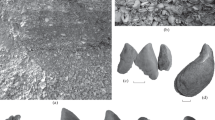Summary
This paper describes the X-ray diffraction studies carried out on a large number of present-day, as well as fossil diatom frustules. From the diffraction patterns given by the various specimens, it has been concluded that the silica present in diatom frustules is not in an amorphous or sub-colloidal state as was spposed by previous workers but that it is crystalline α-quartz. Although crystalline α-quartz is present in present-day diatoms, the degree of crystallisation is much less than in the fossilized specimens. In addition to the crystalline quartz content, there is present in all diatoms an organic component which might possibly be a protein. In the present-day diatoms this organic component occurs in considerable proportion so that its X-ray diffraction pattern tends to mask the pattern due to crystalline α-quartz. On fossilization, however, a considerable amount of the protein content is lost, while the silica content becomes more predominant, and more and more crystalline with time. Evidence for the occurrence of pectin in diatoms is also presented.
Similar content being viewed by others
References
Bailey, J. W... “On the existence of polarizing silica in the organic kingdom,”Amer. J. Sci., 1856,21(2), 357–58.
Brieger, F. “Über den Silicium-Stoffwechsel der Diatomeen,”Ber. dtsch. bot. Ges., 1924,42, 347–55.
Cooper, L. H. N... “Factors affecting the distribution of silicate in the North Atlantic Ocean and the formation of North Atlantic deep-water,”J. mar. biol. Ass. U.K., 1952,30, 589–99.
Desikachary, T. V... “Electron microscope studies of Diatoms,”J. Roy. micr. Soc., 1956,76, 9–36.
Ehrenberg, G... “Phosphorsaures Kalk in dem Zahnen and Kieselerde in den Panzer von Infusorien,”Ann. Phys. Lpz., 1834,32, 574.
Einsele, W. and Grim, J... “Ueber den Kieselsäure-gehalt planktonischen Diatomeen und dessen Bedeutung für einige Fragen Oekologie,”Z. Bot., 1938,32, 545–90.
Geissler, U. Von... “Das membranpotential einiger Diatomeen und seine Bed, eutung für die lebende Kieselalgen-zelle,”Mikroskopie-Wien, 1958,13 (5/6), 145–72.
Hahn, F. von... “Ueber ein proteinartiges gel in den Kieselguralgen der Lüneberger Heide,”Koiloidzeitschr. 1925,37, 300–03.
Jörgensen, E. G... “Solubility of the silica in Diatoms,”Physiol. Plant. 1955,8, 846–51.
Kahane, E... “Sur la silice de silicodermés,”Bull. Soc. chim. biol., Paris, 1935,17, 1554.
Kützing, F. T. ..Die Kieselschaligen Bacillarien oder Diatomeen, Nordhuasen W. Köhne, 1844, pp. 152.
Liebisch, W... “Experimentelle and kritische Untersuchungen über die Pektinmembran der Diatommen und der besonderer Berücksichtigung der Auxosporenbildung und der Kratikularzustände,”Z. Bot., 1929–30,22, 1–65.
Mangin, L... “Observations sur less Diatomee,”Ann. Sci. nat. Bot., 9th Ser., 1908,8, 177–219.
Murray, J. and Penard, A. F...Report on deep-sea deposits based on the specimens collected during the voyage of H.M.S. Challenger in the years 1872–76,Chailenger Rep., 1891,3, 1–525.
Naumann, E... “Die Eisenorganismen,”Int. Rev. Hydrobiol., 1930,24, 81.
Novotscherkesk..Neues, Jahrb. Min., 1925,1, 512 (Not seen in original)
Pia, J...Pflanzen als Gesteinbilder, Bornträger, Berlin, 1926, pp. 355.
Richter, O... “Die Ernahrung der Algen,”Monogr. internat. Rev. Hydrobiol. Hydrogr., 1911,2, 1–192.
Rogall, E... “Über die feinbau der Kieselmembran der Diatomeen,”Planta, 1939,29, 279–91.
Samoilov, Y. V. and Roskhova, E. V. “Deposits of silica of organic origin—silicobioliths,”Trans. Inst. econ. Min. Moscow, 1925,18, 1–76.
Sjostedt, G... “Om järnut fällning hos hafsalger vid skanes kuster,”Bot Notiser, Lund., 1921,1921, 101.
Vinogradov, A. P... “The chemical composition of Plankton III,”Trav. Lab. Biogeochim. U.R.S.S., 1939,5, 47.
—————..The Elementary Chemical Composition of Marine Organisms Translated by J. Efron and J. K. Setlow, Mem Sears Foundation for Marine Research, Bingham Oceanographic Laboratory, New Haven, 1953.
Weiss, A... “Zum Baue und der Natur der Diatomeen,”S. Akad. Wiss. Wien. Math. Natur. Kl. 1871,63, (Abstract 1), 83.,
Author information
Authors and Affiliations
Rights and permissions
About this article
Cite this article
Desikachary, T.V., Dweltz, N.E. The chemical composition of the diatom frustule. Proc. Indian Acad. Sci. 53, 157–165 (1961). https://doi.org/10.1007/BF03051518
Received:
Issue Date:
DOI: https://doi.org/10.1007/BF03051518




